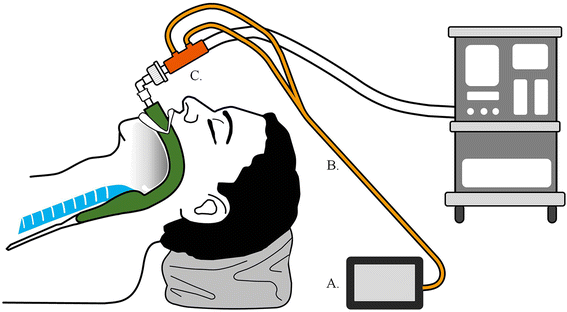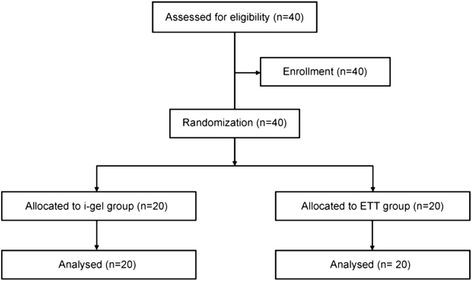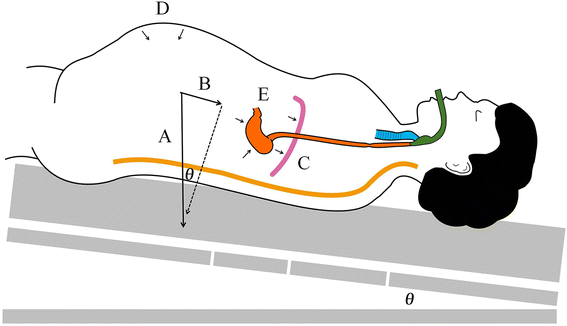I-Gel is a suitable alternative to endotracheal tubes in the laparoscopic pneumoperitoneum and trendelenburg position
- PMID: 28125979
- PMCID: PMC5267400
- DOI: 10.1186/s12871-016-0291-1
I-Gel is a suitable alternative to endotracheal tubes in the laparoscopic pneumoperitoneum and trendelenburg position
Abstract
Background: The use of supraglottic airway devices (SADs) in surgeries with laparoscopic pneumoperitoneum and Trendelenburg (LPT) positioning is controversial due to concerns about insufficient pulmonary ventilation and aspiration. In this prospective, randomized-controlled trial, we evaluated whether the i-gel, a new second generation SAD, provides an effective alternative to an endotracheal tube (ETT) by comparing respiratory parameters and perioperative respiratory complications in non-obese patients.
Methods: In a randomized controlled trial, forty anesthetized patients with ASA I-II were divided into equally sized i-gel and ETT groups. We evaluated the respiratory parameters in the supine and LPT position in comparison between the two groups. The leak fraction was our primary outcome, which was defined as the leak volume divided by the inspired tidal volume. The leak volume was the difference between the inspired and expired tidal volumes. We also monitored pulmonary aspiration and respiratory complications during the perioperative period.
Results: In the LPT position, there were no differences in the leak fraction (median [IQR]) between the i-gel and ETT groups (6.20[3.49] vs 6.38[3.71] %, P = 0.883). In the i-gel group, notably less leakage was observed in the LPT position than in the supine position (median [IQR]: 7.01[3.73] %). This phenomenon was not observed in the ETT group. The rate of postoperative sore throat was also significantly lower in the i-gel group than in the ETT group (3/17 vs 9/11). No vomitus nor any signs associated with aspiration were noted in our patients after extubation in the follow-up prior to discharge.
Conclusions: The i-gel provides a suitable alternative to an ETT for surgeries with LPT positioning in non-obese patients.
Trial registration: Registered at Clinicaltrials.gov NCT02462915 , registered on 1 June 2015.
Keywords: Endotracheal tube; Laparoscopic surgery; Leak fraction; Pneumoperitoneum; Respiratory parameters; Trendelenburg position; i-gel.
Figures




Similar articles
-
Comparison of airway management without neuromuscular blockers in laparoscopic gynecological surgery.Medicine (Baltimore). 2021 Feb 19;100(7):e24676. doi: 10.1097/MD.0000000000024676. Medicine (Baltimore). 2021. PMID: 33607806 Free PMC article. Clinical Trial.
-
Ventilatory performance of BASKA mask as an alternative to endotracheal intubation in short-term gynecologic laparoscopic procedures: a prospective randomized clinical trial.Minerva Anestesiol. 2022 Dec;88(12):994-1002. doi: 10.23736/S0375-9393.22.16492-8. Epub 2022 Mar 23. Minerva Anestesiol. 2022. PMID: 35319853 Clinical Trial.
-
Comparison of the oropharyngeal leak pressure between three second generation supraglottic airway devices during laparoscopic surgery in pediatric patients.Paediatr Anaesth. 2022 Jul;32(7):843-850. doi: 10.1111/pan.14447. Epub 2022 Apr 5. Paediatr Anaesth. 2022. PMID: 35338764 Clinical Trial.
-
Bilateral Otorrhagia after Robotically Assisted Gynecologic Surgery in the Setting of a Reduced Trendelenburg Position and Low-Pressure Pneumoperitoneum: A Case Report and Review of the Literature.J Minim Invasive Gynecol. 2017 Nov-Dec;24(7):1229-1233. doi: 10.1016/j.jmig.2017.04.009. Epub 2017 Apr 28. J Minim Invasive Gynecol. 2017. PMID: 28461176 Free PMC article. Review.
-
Adverse events related to Trendelenburg position during laparoscopic surgery: recommendations and review of the literature.Curr Opin Obstet Gynecol. 2018 Aug;30(4):272-278. doi: 10.1097/GCO.0000000000000471. Curr Opin Obstet Gynecol. 2018. PMID: 29939851 Review.
Cited by
-
Comparative evaluation of airway dynamics in patients undergoing laparoscopic cholecystectomy under general anaesthesia with controlled ventilation using ProSeal laryngeal mask airway, I-Gel™ and Baska mask.Indian J Anaesth. 2022 Dec;66(12):842-848. doi: 10.4103/ija.ija_827_21. Epub 2022 Dec 20. Indian J Anaesth. 2022. PMID: 36654901 Free PMC article.
-
Second generation laryngeal mask airway during laparoscopic living liver donor hepatectomy: a randomized controlled trial.Sci Rep. 2021 Feb 11;11(1):3532. doi: 10.1038/s41598-021-83173-5. Sci Rep. 2021. PMID: 33574495 Free PMC article. Clinical Trial.
-
Comparison of clinical performance of i-gelⓇ and Baska MaskⓇ during laparoscopic cholecystectomy.Korean J Anesthesiol. 2019 Dec;72(6):576-582. doi: 10.4097/kja.19195. Epub 2019 Aug 20. Korean J Anesthesiol. 2019. PMID: 31426623 Free PMC article. Clinical Trial.
-
Comparative study of the Ambu® AuraOnce™ laryngeal mask and endotracheal intubation in anesthesia airway management during neurosurgery.J Int Med Res. 2020 Feb;48(2):300060520902606. doi: 10.1177/0300060520902606. J Int Med Res. 2020. PMID: 32036718 Free PMC article. Clinical Trial.
-
AuraGain and i-Gel laryngeal masks in general anesthesia for laparoscopic cholecystectomy. Performance characteristics and effects on hemodynamics.Saudi Med J. 2018 Nov;39(11):1082-1089. doi: 10.15537/smj.2018.11.22346. Saudi Med J. 2018. PMID: 30397706 Free PMC article.
References
-
- Ng A, Smith G. Gastroesophageal reflux and aspiration of gastric contents in anesthetic practice. Anesth Analg. 2001;93:494–513. - PubMed
Publication types
MeSH terms
Associated data
LinkOut - more resources
Full Text Sources
Other Literature Sources
Medical

